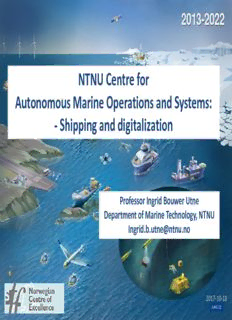
AMOS – Autonomous Shipping and digitalization PDF
Preview AMOS – Autonomous Shipping and digitalization
2013-2022 NTNU Centre for Autonomous Marine Operations and Systems: - Shipping and digitalization Professor Ingrid Bouwer Utne Department of Marine Technology, NTNU [email protected] 2017-10-18 Content • Introduction to AMOS – Overview – Research areas and focus • Important concepts – Autonomy, risk and risk management • Risk monitoring and risk control – High Reliability Management (HRM) • ROV vs. DP – Reactive vs. deliberative control • Conclusions 2 Overview of Centre of Excellence INTRODUCTION TO AMOS NTNU AMOS Vision • Establish a world-leading research centre on autonomous marine operations and systems • Create fundamental knowledge through multidisciplinary research • Provide cutting-edge interdisciplinary research to make autonomy a reality for ships and ocean structures, unmanned vehicles and marine operations NTNU AMOS will contribute to improved international competitiveness of Norwegian industries as well as to safety and protection of the marine environment Next step in research, education and innovation Hydrodynamics and Guidance, Navigation Marine Biology and Structural Mechanics and Control Oceanography Knowledge fields & research methods Autonomy: Big Data Cybernetics, Sensor Fusion, Computer Vision, Artificial Intelligence, Experiments Optimization NTNU AMOS NTNU Centre for Autonomous Marine Operations and Systems Interdisciplinary Greener Autonomous research operations surveillance areas & challenges Offshore renewable Open water biological energy production Oil & gas in deeper …. and in Arctic water… areas NTNU AMOS Facts and Figures (Phase 1: 2013-2017) Personnel by January 2017: Logo on partners 6 Key scientists/professors 2 Scientific advisors/professors 9 Adjunct professors 14 Affiliated professors 13 Post Docs/researchers 84 PhD candidates (on going) 2 administrative staff 2 + lab engineers 3 Spin off companies 36 Educated PhDs Director: Asgeir J. Sørensen Partners: International collaborators from: Denmark, Sweden, Portugal, Italy, Croatia, the Netherlands, Estonia, Check Republic, USA, Australia, Brazil, Ukraine, UK, Singapore National collaborators: University of Tromsø, UNIS, UNIK, Kongsberg Maritime, Rolls-Royce Marine, TechnipFMC, Ecotone, Maritime Robotics, FFI, NGU, Ulstein Group, Eelume, NORUT, Marine Technologies, BluEye, … Budget (10 years): 830+ MNOK (~95 MEUR) Autonomous ships AMOS’ RESEARCH Why autonomy? More intelligent systems that depend less on human operators Unique (or cheaper) solution when no (or limited) communication is available (bandwidth, remoteness) Unmanned systems may be smaller, lighter, cheaper and safer to deploy and operate Qualified operators may be a shortage Mandatory for new functions Enables complex functionality; provides fault tolerance and robustness Enables operations in complex, harsh and remote environment (Dull/Dirty/Dangerous Operations) Next step towards autonomous operations and systems ….. “Drone ships would be safer, cheaper and less polluting for the $375 billion shipping industry that carries 90 percent of world trade” , Rolls-Royce says Unmanned cargo ships could become a reality on our oceans within the decade, according to manufacturer Rolls-Royce. Yara and Kongsberg plan test operation from late 2018 with small crew, located in a modular unit which can be lifted off. Testing with remote control and operation starts in 2019, before the ship in 2020 will set sail autonomously between Porsgrunn, Brevik and Larvik. Oil and gas The world’s first autonomous passenger ferry between Fisheries and Ravnkloa and Vestre Kanalhavn, Trondheim. Testing starts in 2017, and from 2018 passenger transport will start, if Aquaculture permission is granted from the Maritime Directorate. http://www.bloomberg.com/news/2014-02-25/rolls-royce-drone-ships-challenge-375-billion-industry-freight.html https://www.tu.no/artikler/skal-vaere-klar-til-bruk-i-2020-na-testes-verdens-forste-autonome-containerskip/408426 https://www.tu.no/artikler/verdens-forste-forerlose-passasjerferge-kan-ga-over-en-kanal-i-trondheim/363790 30 September 2016: Test site opened for autonomous vessels The Trondheim Fjord in Norway will be the world’s first technological playground for pilotless vehicles that move below, on and above the water’s surface. Norwegian authorities, industry, research and universities are behind this.
Description: